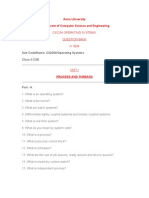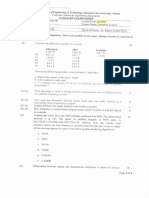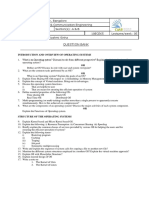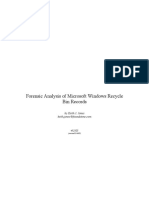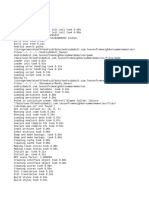OPERATING SYSTEM
IMPORTANT QUESTIONS:
Chapter 1:
1.what is Operating System? Give the view of OS as Resource Manager.
2. Explain different types of OS.
3. Give the view of OS as User Interface.
4. What is system call? Explain the types of system call.
5. Write different operating system services.
6. What is spooling?
7. Explain the structure of operating system.
8. What is kernel? Explain types of kernel.
CHAPTER 2:
1. What is Process? Give the difference between a process and a program.
2. Explain the Process State transition diagram.
3. Explain Process Control Block (PCB)?
4. Difference between process and thread.
5. What is scheduler? Explain queuing diagram representation of process
scheduler with figure.
6. What is thread? Explain thread structure.
7. Explain process creation and process termination.
8. Explain types of thread.
9. Five batch jobs A to E arrive at same time. They have estimated running
times 10,2,6,8,4 minutes. Their priorities are 3,2,5,4,1 respectively with 5
being highest priority. For each of the following algorithm determine mean
process turnaround time. Ignore process swapping overhead. Round Robin
(q=3), Priority Scheduling, FCFS, SJF.
10.Draw Four Gantt charts illustrating the execution of these processes using
FCFS, SJF, priority (a small priority number implies a higher priority), and
Round Robin (quantum=1) scheduling.
11.Five batch jobs A to E arrive at same time. They have estimated running
times 10,6,2,4 and 8 minutes. Their priorities are 3,5,2,1 and 4 respectively
with 5 being highest priority. For each of the following algorithm determine
mean process turnaround time. Ignore process swapping overhead. Round
Robin, Priority Scheduling, FCFS, SJF.
12. Assume arrival order is: P1, P2, P3, P4, P5 at time 0,1,2,3,4 respectively
and a smaller priority number implies a higher priority. Draw the Gantt charts
for preemptive and non-preemptive priority scheduling. Calculate Average
Turnaround Time and Average Waiting Time.
�CHAPTER 3:
1. What do you mean by Deadlock Avoidance? Explain the use of Banker’s
Algorithm for Deadlock Avoidance with illustration.
2. What is Deadlock? List the conditions that lead to deadlock. How Deadlock
can be prevented?
3. What is Deadlock? Explain Deadlock prevention & Avoidance.
4. How Resource Trajectories can be helpful in avoiding the deadlock?
5. What is Deadlock? List the conditions that lead to deadlock. How Deadlock
can be prevented?
6. Define: Mutual Exclusion,
7. What is Semaphore? Give the implementation of Bounded Buffer Producer
Consumer Problem using Semaphore.
8. What is Semaphore? Give the implementation of Readers-Writers Problem
using Semaphore.
CHAPTER 4:
1. What is Virtual Memory? Explain
2.What is paging? What is Page Table? Explain the conversion of Virtual
Address to Physical Address in Paging with example.
3. Explain the concept of Segmentation for Memory Management. Explain
why combined Paged Segmentation is used with illustration.
4. For the Page Reference String: 7, 0, 1, 2, 0, 3, 0, 4, 2, 3, 0, 3, 2, 1, 2, 0. 1.
7, 0, 1 Calculate the Page Faults applying (i)Optimal(ii)LRU and(iii)FIFO Page
Replacement Algorithms for a Memory with three frames.
5. Explain the various page replacement strategies.
6. Given memory partition of 100K, 500K, 200K, 300K, and 600K in order,
how would each of the First-fit, Best-fit and Worst-fit algorithms place the
processes of 212K, 417K, 112K and 426K in order? Which algorithm makes
the most efficient use of memory?Show the diagram of memory status in
each case.
7. What is segmentation? Explain it with example.
8. Consider the following page reference string: 1, 2, 3, 4, 2, 1, 5, 6, 2, 1, 2,
3, 7, 6, 3, 2, 1, 2, 3, 6. How many page faults would occur for the following
replacement algorithms, assuming four frames? Remember all frames are
initially empty, so your first unique pages will all cost one fault each.LRU
replacement, FIFO replacement
9.Explain the various page replacement strategies.
10. Given memory partition of 100K, 500K, 200K, 300K, and 600K in order,
How would each of the First-fit, Best-fit and Worst-fit algorithms place the
�processes of 212K, 417K, 112K and 426K in order? Which algorithm makes
the most efficient use of memory? Show the diagram of memory status in
each cases.
11.Explain swapping in memory management.
CHAPTER 5:
1.Explain various Disk Scheduling Algorithms with illustration
2. Suppose that a disk drive has 5000 cylinders, numbered 0 to 4999. The
drive is currently serving a request at cylinder 143, and the previous
request was at cylinder 125. The queue of pending requests, in FIFO
order, is - 86, 1470, 913, 1774, 948, 1509, 1022, 1750, 130. Starting from
the current head position, what is the total distance (in cylinders) that the
disk arm moves to satisfy all the pending requests, for each of the
following disk scheduling – FCFS , SCAN ( elevator).
3. Disk requests come in to the disk for cylinders 10, 22, 20, 2, 40, 6 and
38. A seek takes 6 msec per cylinder move. How much seek time is for
Closest cylinder next algorithm? Initially arm is at cylinder 20.Starting
track at 100.The queue of pending request is,
55,58,39,18,90,160,150,38,184 – FCFS, SCAN ( elevator), SSTF,C SCAN
4. Suppose that a disk drive has 1000 cylinders, numbered 0 to 999.
Assume last request received was at track 345 and the head is moving
towards track 0. The queue of pending requests, in FIFO order, is
123,874,692,475,105,367. Perform following scheduling algorithm. FIFO ,
SSTF,SCAN,LOOK,C-SCAN,C-LOOK
5.Disk request come in to the driver for cylinder 10,22,20,2,40,6 and
38.A seek takes 6 msec per cylinder moved . How much seek time
needed for FCFS ,Closet cylinder next diagram. Initially arm is at cylinder
20.Starting track at 100. The queue of pending request is,
27,129,110,186,147,41,10,63,120 – SSTF , C-SCAN,C-LOOK.
6.Disk head is start at 53.. The queue of pending request is, 98,183,
37,122,14,124,65,67. - FCFS , SSTF,SCAN,C-SCAN, LOOK
8.Suppose that a disk drive has 5000 cylinders, numbered 0 through
4999.The drive is serving a request at cylinder 143. FIFO order is, 86,
1470, 913, 1774,948,1509,1022,1750,130 starting from head position.
What is total distance? FCFS, SSTF, SCAN, LOOK, C SCAN, C-LOOK.





















